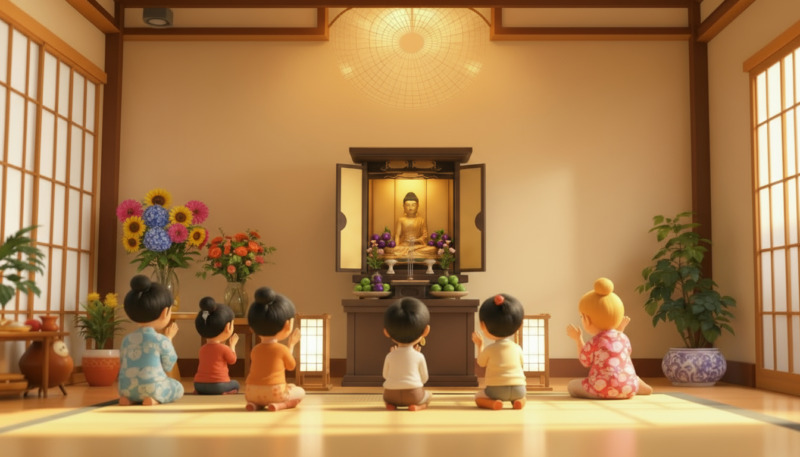(At Ryuganji Temple, the head priest writes a monthly Buddhist column on the bulletin board in front of the gate. This is the column for August 2025.)
Frequently Asked Question
In Japan, the Buddhist observance known as Obon is held around August 15th. It has long been believed that during Obon, ancestors return to this world.
Therefore, every August, we receive questions from parishioners asking, “How should we prepare offerings for the Buddhist altar during Obon?”
This is especially common from families observing their first Obon after a loved one has passed.Their feelings are a mixture of determination—“Since it is the first Obon, I want to make the offerings with care”—and anxiety—“I have suddenly become responsible for arranging the family altar, and I am unsure what to do.”
In fact, this is not an easy question to answer. Since childhood, I have seen many different home altars. In farming families, I often saw cucumbers, eggplants, and tomatoes—seasonal summer vegetables—offered in abundance. On the other hand, in some homes the altar looked no different from usual, with only the standard offerings placed before the Buddha.
In other words, the “right way” to arrange offerings depends greatly on each household’s traditions, the size of the altar, and other circumstances. Even the simplest offerings are a sufficient expression of gratitude and remembrance, as long as they are made with sincerity. That is why, to be honest, this question is difficult to answer clearly.
Answers from the Internet
You may find more detailed explanations online than I can provide. For example, websites often explain with illustrations the custom of making a cow from an eggplant(see below) and a horse from a cucumber, or the tradition of hanging a white lantern for the first Obon.
However, the internet is overflowing with information, which can sometimes cause more confusion than clarity. In the end, many people still come to ask me directly. Even if they have followed a model example found online, they still worry: “Is this really okay?”

Ask While You Still Can
This is why I always urge people: “While your parents are still well, ask them how they observe memorial offerings for the ancestors.” Some families prepare the same menu of food offerings every year, decided in advance. If you can learn that menu directly from your parents while they are alive and continue it faithfully, then you can feel confident in your way of honoring them, and your offerings will naturally carry heartfelt meaning. These “family rules” are never written on the internet, and once lost, they cannot be recovered. I sincerely hope people will make the effort to preserve them.
Unfortunately, however, cases where these “family rules” are lost are all too common. In such instances, relying on online information and creating your own meaningful way of making offerings may itself be the most natural and contemporary form of practice.







No comments yet.